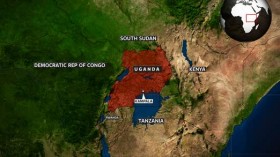The deadly Ebola virus has killed 14 people in western Uganda this month, health officials have confirmed.
The announcement ends weeks of speculation about the cause of a strange disease that had many people fleeing their homes – officials had previously dismissed the suggestion of Ebola as “merely a rumour”.
The officials and a World Health Organisation representative confirmed the report at a news conference in the country’s capital, Kampala.
“Laboratory investigations done at the Uganda Virus Research Institute…have confirmed that the strange disease reported in Kibaale is indeed Ebola hemorrhagic fever,” the two groups said in a joint statement.
Kibaale is a district in midwestern Uganda, where people in recent weeks have been troubled by a mysterious illness that seemed to have come from nowhere.
 Ugandan health officials had been perplexed as well, and spent weeks conducting laboratory tests that were at first inconclusive.
Ugandan health officials had been perplexed as well, and spent weeks conducting laboratory tests that were at first inconclusive.
Health officials told reporters in Kampala that the 14 dead were among 20 reported with the disease. Among those who died were a woman and her four-month-old baby. Two of the infected have been isolated for examination by researchers and health officials.
Ugandans are being urged to stay calm, with officials saying a national emergency taskforce has been set up to stop the disease from spreading far and wide.
Ebola, which manifests itself as a hemorrhagic fever, is highly infectious, kills quickly and there is no known cure.
It was first reported in 1976 in Congo and is named after the river where it was recognised.
A factsheet on Ebola from the Centres for Disease Control and Prevention says the disease is “characterised by fever, headache, joint and muscle aches, sore throat, and weakness, followed by diarrhoea, vomiting, and stomach pain”.
It adds: “A rash, red eyes, hiccups and internal and external bleeding may be seen in some patients.”
[adrotate banner=”48″]

